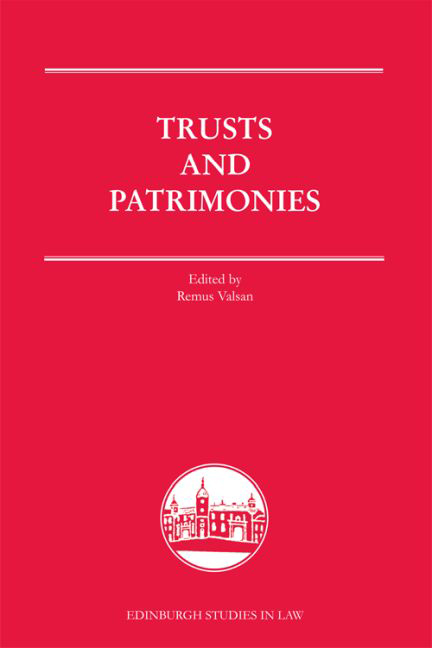Book contents
- Frontmatter
- Contents
- Preface and Acknowledgements
- List of Contributors
- List of Abbreviations
- Table of Cases
- INTRODUCTION
- PART I PATRIMONY AND THE COMMON LAW TRUST
- PART II PATRIMONY AND THE SCOTTISH TRUST
- 5 Trusts without Equity
- 6 Patrimony not Equity: The Trust in Scotland
- 7 Scottish Trusts in the Common Law
- PART III TRUST AND PATRIMONY IN FRANCE, QUEBEC AND THE NETHERLANDS
- Index
6 - Patrimony not Equity: The Trust in Scotland
from PART II - PATRIMONY AND THE SCOTTISH TRUST
Published online by Cambridge University Press: 15 September 2017
- Frontmatter
- Contents
- Preface and Acknowledgements
- List of Contributors
- List of Abbreviations
- Table of Cases
- INTRODUCTION
- PART I PATRIMONY AND THE COMMON LAW TRUST
- PART II PATRIMONY AND THE SCOTTISH TRUST
- 5 Trusts without Equity
- 6 Patrimony not Equity: The Trust in Scotland
- 7 Scottish Trusts in the Common Law
- PART III TRUST AND PATRIMONY IN FRANCE, QUEBEC AND THE NETHERLANDS
- Index
Summary
LAW AND EQUITY: A FALSE START
The opening words of William F Fratcher's volume on Trust in the International Encyclopaedia of Comparative Law are these:
The trust is a legal device developed in England whereby ownership of property is split between a person known as a trustee, who has the rights and powers of an owner, and a beneficiary, for whose exclusive benefit the trustee is bound to use those rights and powers.
This is a traditional definition. The trust, we are told, is English in origin, and its central feature is the division of ownership between trustee and beneficiary. At those words a lawyer from a civil law system is likely to be impressed but also discouraged: impressed, because the edifice of thought on which the English trust is based commands respect and admiration; discouraged, because a device which depends on a division of dominium into legal and equitable ownership is not only unsuitable for transplantation to civilian soil: it is barely comprehensible.
Trust law need not be like this. Indeed the argument of this chapter is that trust law is not like this. Even in English law the legal/equitable duality may no longer be the most important characteristic of the trust. But in any event trusts are not confined to English law, or to common law systems based on that law. Scotland, a mixed jurisdiction, has known the trust since at least the seventeenth century. In other mixed jurisdictions, notably South Africa, Quebec and Sri Lanka, trusts began to appear in the nineteenth century, with Louisiana following after the First World War. The law of property in mixed legal systems is always civilian; like civil law countries, they do not have a separate system of equity, or acknowledge the distinction between legal and beneficial ownership; and yet all mixed systems have the trust.
Where mixed legal systems led, the civil law world in due course began to follow. Most of the early development was in Latin America – in Colombia (1923), Panama (1925), Chile (1925), Mexico (1926), Bolivia (1928), Peru (1931), Costa Rica (1936), Venezuela (1940), Nicaragua (1940), Guatemala (1946), Ecuador (1948) and Honduras (1950). In the civilian parts of Asia only Japan adopted the trust, in 1922, and the institution was largely ignored in continental Europe with the exception of tiny Liechtenstein (1926).
- Type
- Chapter
- Information
- Trusts and Patrimonies , pp. 110 - 126Publisher: Edinburgh University PressPrint publication year: 2015



